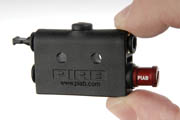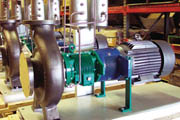
The act helped kick-start a change that already was underway in how food handling equipment is evaluated in terms of sanitation. Instead of allowing food equipment fabricators to self-certify, a third-party verification (TPV) program would take over the role. 3-A Sanitary Standards Inc. was created to administer the program. Among the first equipment categories subject to TPV review are pumps and valves.
TPV was needed, according to Tim Rugh, 3-A Inc.'s executive director, because vague wording in the standards allowed different interpretations of the requirements. Some public health inspectors complained about inconsistencies in the 750 pieces of equipment bearing the 3-A symbol. The solution is a TPV credential program in which 29 conformance evaluators were accredited in 2003. "It's not a matchbook credential," Rugh emphasizes. "Not everyone passed."
TPV was to be required for centrifugal and positive displacement (PD) pumps in 2003, but the program is on hold while fabricators, regulators and end-users try to reach consensus over a concealed area in lobe pumps. Pump fabricators hope the issues can be resolved by midyear. TPV for valves also is phasing in this year.
While 3-A is firmly rooted in the dairy segment, it has become the Good Housekeeping seal for the entire food and beverage industry. The same concern for food safety that led to the standard's creation in dairy is driving its adoption in other segments, with the full force and involvement of USDA. "They're really becoming much more proactive in addressing cleanability issues than they were five years ago," believes Bill Rice, technical lead for pumps at Waukesha Cherry-Burrell in Delevan, WI, and USDA's input into 3-A is a manifestation of that. Meat and poultry processors in particular are demanding pumps and valves that meet or beat 3-A's sanitary standards.
Waukesha and other suppliers have offered solid-metal construction as a higher-quality option to castings for years. The difference today is that more food manufacturers are specifying solid metal, which reduces the likelihood of crevices that can harbor bacteria. Higher quality alloys are also being offered: Waukesha's Universal II PD pumps have a standard 316 stainless steel body, with 316L low-carbon construction as an option, a grade that is immune to grain boundary carbide precipitation. The molybdenum in both alloys provides high resistance to pitting and crevice corrosion from chlorine rinse.

Besides eliminating crevices, solid materials have allowed Softwave to develop innovations that would not be possible with castings. A straight-line, internal, seal-flushing back plate provides a superior system to external piping loops in terms of sanitation and inspection, and a zero dead-leg drain ensures no residuals are left after a CIP cycle. In some pumps, particles can accumulate in a tube at the bottom of the casing until it is opened and fully drained.
Certification from 3-A was in place at Softwave's inception, and Holdorf expects to receive TPV in the coming months. "Certification is a fundamental need; it separates the men from the boys," he says. "End users assume you're legit if you have 3-A."
Waukesha, Fristam, Alfa Laval and other international suppliers must meet the standards of both 3-A and the European Hygienic Engineering & Design Group (EHEDG). Which standard is more exacting is a matter of opinion. US evaluation is geared to sight, smell and smear: if residual grease can be detected after cleaning a butter pump, for example, the unit doesn't pass muster. In the EU, swab tests for bacteria counts are the measure.
"We actually manufacture to both standards," says Waukesha's Rice. "Swab tests take the opinion out of it. Realistically, if a pump cleans to standard in Europe, it will clean here, but not vice versa."
Sam Raimond, a service technician with Middleton, WI-based Fristam, disagrees. "When our pumps came here from Germany in the 1970s, they had to be modified. Our pumps are held to a much higher cleanability standard in the United States than they would be in Europe."
A major redesign of its high-pressure sanitary pumps in the late 1990s leaves Product Manager Dick Sliwinski confident Moyno Inc.'s progressive cavity pumps will easily pass muster in the TPV program. The Columbus, OH, firm's sanitary units have been 3-A approved since 1968, when the standard was established.
Moyno's technology traces back to 1926, when a French engineer designed a supercharger for jet engines. The air-pumping technology was transferred to liquids, and the Moyno pump was born. By adding up to nine seals in succession, engineers can achieve pressures of up to 600 psi, even for highly viscous products, and with low sheer, according to Sliwinski. A single eccentric-screw pump can replace two stuffed lobe pumps in a configuration, reducing maintenance costs while eliminating the danger created when one of two lobe pump fails, he adds.
Valves under pressure
Solid-piece construction is occurring with valves, as well as pumps; better fit, quality and consistency are among the benefits, suggests Jim McCoy, sales manager for Rockford, IL-based Sudmo NA. Solid pieces also open the door to certifiable alloys such as AL 6XN, which contains six times the ratio of molybdenum as standard stainless steel, he says.
Validating compliance with the Pasteurized Milk Ordinance (PMO) for mix-proof valves also has been a priority for fabricators in recent years. Sudmo won FDA approval for a mix-proof valve designed to handle cheese-curd particulate measuring 42-46 mm (1.6-1.8 inches) in 2003, and Pleasant Prairie, WI-based Alfa Laval received similar approval for its Unique PMO cheese-curd valve on December 11, 2003. By garnering the FDA's blessing, Sudmo and Alfa Laval spare manufacturers the need to gain approvals from state inspectors.
Breweries and other processors have leveraged the automation advantages of mix-proof valves for 20 years, according to Mark Ream, Alfa Laval's process improvement manager. "Larger processors understand the value of mix-proof and are slowly and steadily embracing the technology," he says. "As public health requirements become tighter, you'll see more manufacturers applying them."
Dairy was the proving ground for another niche product: washdown-ready pneumatic valve manifolds from Bosch Rexroth. The fiber-reinforced polymer enclosing the working parts adds some cost, concedes Kjell Lyngstad, food & beverage segment manager for Bosch Rexroth's pneumatics group in Lexington, KY, but the difference is recouped many times over by eliminating the need for expensive NEMA-6 protective cabinets. A dairy specified the grayish valve covering because it makes dirt and grime more visible.
"It's old technology that is being glammed up a little," Lyngstad says of the new-look pneumatic valves. Some food manufacturers would like to replace pneumatics with electronic servos and drives, "but pneumatic is still considered to be the best technology in washdown environments," he points out. And washdown environments are becoming more aggressive, particularly in plants inspected by USDA.
Goodman Packaging, a machine fabricator in Waukegan, IL, installed a six-station manifold with the Rexroth valves in a primary packaging machine that went into service at a Tyson Foods plant in Union City, TN, in October. A four-station system was installed at Tyson's Nashville, AR, facility in November. "They really drench those valves during washdown," says Mike Bushing, Goodman service manager. "We haven't had any problems with the seals yet."
Placing the valves adjacent to the actuators means an improvement of up to 30 percent in response time, compared to valves in a remote cabinet, Lyngstad notes. "It's a brand new way of designing pneumatic machinery," and that poses a barrier to adoption, but the lower fabrication costs and adaptability to high-pressure washdown should win converts, he predicts.
First one is free
Processors often take a pass on premium pumps because of short-term capital thinking, about which many engineers complain. Some see parallels to the drug pusher philosophy: the first fix is free, and then the junkie pays and pays. The first inexpensive pump isn't free, of course, but the analogy holds up: the purchase price of in-suction centrifugal pumps represents four to five percent of lifecycle costs, studies by DuPont and others indicate. Spare parts are the real profit center, and that encourages manufacturers to price commodity pumps as loss leaders, according to Dave Mikalonis, an engineer with SKF Inc., Kulpsville, PA.
SKF recently forged a distribution partnership with Environamics, a Hudson, NH, pump manufacturer that developed a bearing frame assembly with a completely enclosed mechanical seal chamber in a solid housing for optimal strength. The housing is flush against the pump, with no stuffing box for the seals. An adapter plate makes the unit compatible with any in-suction centrifugal pump.
"People have used the same old casting designs for 60 years," says Mikalonis. "It becomes the norm to rebuild a pump once or twice a year, and it doesn't need to be that way." Because of the reduced stress, SKF is offering a three-year warranty on seals in universal power frames.
An even greater benefit than reduced maintenance was the elimination of air suction in tests at an Anheuser-Busch brewery. The St. Louis firm has identified oxygen infiltration at pumps, valves, seals and fittings as a major culprit in product variability. When product flow is interrupted, cavitation occurs, and air is sucked from the atmosphere into the pump. "Mechanical seals on the pumps are one of the worst problem areas," says Mikalonis. "We can take the amount of oxygen entering down to virtually zero." Bacterial counts also are sharply reduced, minimizing a source of off flavors.
Pumps and valves are ubiquitous in processing facilities, and sanitary design isn't always a necessity. Once product has been packaged, it isn't even a consideration. Efficiency always is a concern, however, and compressed air-driven and electro-mechanical pumps are the most frequently applied vacuum technologies in packaging room applications. Rotary vane pumps are most commonly used in fillers and other applications with long cycle times. But if vacuum is needed only 30 percent of the time, air-driven pumps are the way to go, maintains John Holmes, packaging segment manager at Hingham, MA-based PIAB USA Inc.
Despite the multi-stage ejector's efficiency, line diameter and distance from the object result in lost power, and pumps must be oversized to compensate. A more efficient solution is a pump that can be positioned closer to the object being moved. PIAB's answer is the P2010, which generates a vacuum at a feed pressure as low as 26 psi, less than half the pressure of conventional multi-stage ejectors. The pump is small enough to be mounted at the end of a Delta-arm robot for high-speed pick-and-place, according to Holmes. Object density is a limiting factor-a cookie is too porous to achieve the necessary vacuum at low-feed pressures-but for denser products and packaged goods, P2010 can help end users boost throughput while reducing energy consumption, he says.
Improved efficiency and reduced maintenance are ongoing concerns in pump and valve design. First and foremost, however, the equipment must be cleanable and sanitary, and there's a new sheriff in town to ensure it passes muster.
For more information:
Mark Ream, Alfa Laval,
262-947-3712,
Mark.ream@alfalaval.com
Kjell Lyngstad, Bosch Rexroth,
859-913-2330,
Kjell.lyngstad@boschrexroth-us.com
Sam Raimond, Fristam Pumps,
608-831-5001
Dick Sliwinski, Moyno Inc.,
937-327-3254,
dsliwinski@moyno.com
John Holmes, PIAB USA Inc.,
781-682-1460
Dave Mikalonis, SKF Inc.,
215-513-4812,
david.r.mikalonis@skf.com
Tom Holdorf, Softwave Pumps,
608-327-1051
Jim McCoy, Sudmo NA Inc.,
815-871-8103,
jmccoy@sudmona.com
Bill Rice, Waukesha Cherry-Burrell,
800-252-5200, ext. 4670
